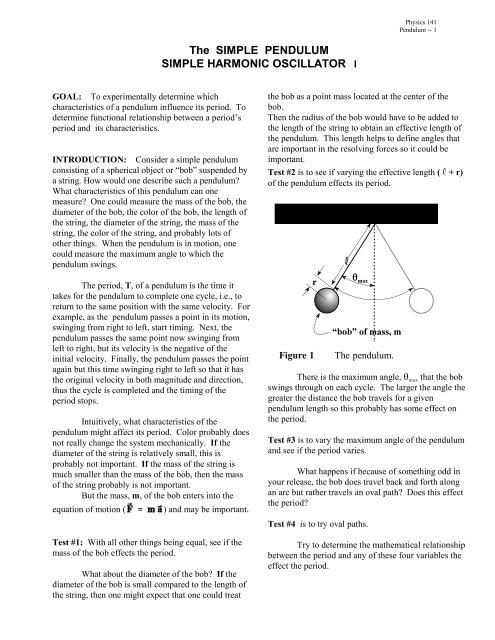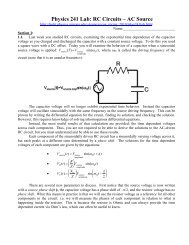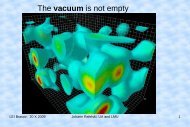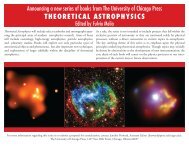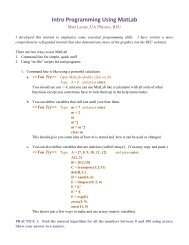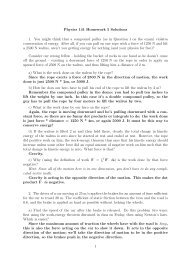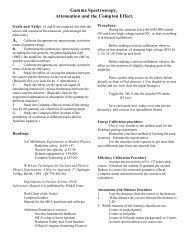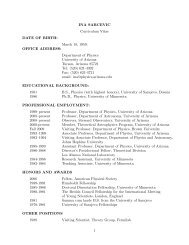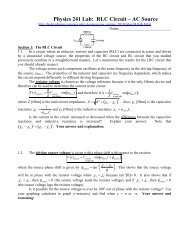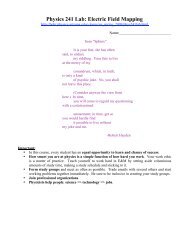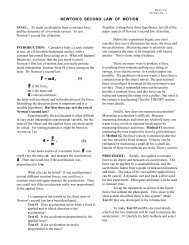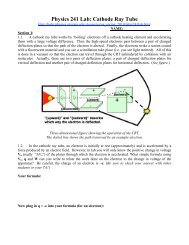The SIMPLE PENDULUM SIMPLE HARMONIC OSCILLATOR I
The SIMPLE PENDULUM SIMPLE HARMONIC OSCILLATOR I
The SIMPLE PENDULUM SIMPLE HARMONIC OSCILLATOR I
You also want an ePaper? Increase the reach of your titles
YUMPU automatically turns print PDFs into web optimized ePapers that Google loves.
GOAL: To experimentally determine which<br />
characteristics of a pendulum influence its period. To<br />
determine functional relationship between a period’s<br />
period and its characteristics.<br />
INTRODUCTION: Consider a simple pendulum<br />
consisting of a spherical object or “bob” suspended by<br />
a string. How would one describe such a pendulum?<br />
What characteristics of this pendulum can one<br />
measure? One could measure the mass of the bob, the<br />
diameter of the bob, the color of the bob, the length of<br />
the string, the diameter of the string, the mass of the<br />
string, the color of the string, and probably lots of<br />
other things. When the pendulum is in motion, one<br />
could measure the maximum angle to which the<br />
pendulum swings.<br />
<strong>The</strong> period, T, of a pendulum is the time it<br />
takes for the pendulum to complete one cycle, i.e., to<br />
return to the same position with the same velocity. For<br />
example, as the pendulum passes a point in its motion,<br />
swinging from right to left, start timing. Next, the<br />
pendulum passes the same point now swinging from<br />
left to right, but its velocity is the negative of the<br />
initial velocity. Finally, the pendulum passes the point<br />
again but this time swinging right to left so that it has<br />
the original velocity in both magnitude and direction,<br />
thus the cycle is completed and the timing of the<br />
period stops.<br />
Intuitively, what characteristics of the<br />
pendulum might affect its period. Color probably does<br />
not really change the system mechanically. If the<br />
diameter of the string is relatively small, this is<br />
probably not important. If the mass of the string is<br />
much smaller than the mass of the bob, then the mass<br />
of the string probably is not important.<br />
But the mass, m, of the bob enters into the<br />
equation of motion ( ) and may be important.<br />
Test #1: With all other things being equal, see if the<br />
mass of the bob effects the period.<br />
What about the diameter of the bob? If the<br />
diameter of the bob is small compared to the length of<br />
the string, then one might expect that one could treat<br />
<strong>The</strong> <strong>SIMPLE</strong> <strong>PENDULUM</strong><br />
<strong>SIMPLE</strong> <strong>HARMONIC</strong> <strong>OSCILLATOR</strong> I<br />
Physics 141<br />
Pendulum -- 1<br />
the bob as a point mass located at the center of the<br />
bob.<br />
<strong>The</strong>n the radius of the bob would have to be added to<br />
the length of the string to obtain an effective length of<br />
the pendulum. This length helps to define angles that<br />
are important in the resolving forces so it could be<br />
important.<br />
Test #2 is to see if varying the effective length ( + r)<br />
of the pendulum effects its period.<br />
Figure 1 <strong>The</strong> pendulum.<br />
<strong>The</strong>re is the maximum angle, max that the bob<br />
swings through on each cycle. <strong>The</strong> larger the angle the<br />
greater the distance the bob travels for a given<br />
pendulum length so this probably has some effect on<br />
the period.<br />
Test #3 is to vary the maximum angle of the pendulum<br />
and see if the period varies.<br />
What happens if because of something odd in<br />
your release, the bob does travel back and forth along<br />
an arc but rather travels an oval path? Does this effect<br />
the period?<br />
Test #4 is to try oval paths.<br />
Try to determine the mathematical relationship<br />
between the period and any of these four variables the<br />
effect the period.
period.<br />
PROCEDURE:<br />
Initially, use the stop watch for measuring the<br />
Make Test #1, 2, & 3. It may be to your<br />
advantage to initially make these tests quickly, because<br />
there may be ranges for these parameters where the<br />
period varies rapidly. You may wish to avoid these<br />
regions when testing the other parameters.<br />
When working with small angles (less than<br />
10°) and smaller balls, you may wish to use the<br />
photogates. <strong>The</strong> suggested settings are: PENDulum<br />
mode., MEMory ON, and either 1 ms or 0.1 ms. DO<br />
NOT HIT THE PHOTOGATE WITH THE BOB!<br />
After general behavior of the period as a<br />
function of each parameter is known, then make<br />
detailed studies of the primary causes of variation.<br />
Use the nature of the linear and maybe a log-log plot to<br />
determine the functional relationship.<br />
Take enough data to make a reasonable<br />
estimate of your errors.<br />
Compare your results to eqs. 6 and 9.<br />
Determine the gravitational constant, g, using<br />
eq.10.<br />
WARNINGS:<br />
DO NOT USE the photogate and timer when<br />
taking preliminary data, working at angles greater than<br />
10° or using heavy bobs. This is to avoid the problem<br />
of the bob hitting and damaging the photogate.<br />
Before using the photogate, practice to obtain<br />
a clean release of the bob, such that the path of the<br />
pendulum is in a plane rather than an ellipse.<br />
Pendulum stands may be at face and eye level,<br />
please be careful. Do not hit yourself or anyone else<br />
with the pendulum.<br />
EQUIPMENT:<br />
Long vertical support rod<br />
Pendulum clamping bar<br />
Table & rod clamps<br />
Stopwatch<br />
Timer & photogate<br />
Meter & ruler<br />
In room<br />
Balance ( triple beam)<br />
Various pendulum bobs<br />
String & scissors<br />
Physics 141<br />
Pendulum -- 2<br />
Equipment notes:<br />
When using a stopwatch to measure the period<br />
of the pendulum, measuring more than one (maybe<br />
ten) cycles and then dividing by the number of cycles<br />
may help reduce errors associated with your reflexes.<br />
When using the stopwatch for timing,<br />
Be careful not to count the initial half<br />
cycle as a full cycle.<br />
As the pendulum swings through the<br />
bottom of its swing and you start the<br />
stopwatch, be careful to start counting<br />
at zero and not one.<br />
Be careful that the string is clamped equally<br />
on both sides. Otherwise the length of the pendulum<br />
may be not longer on one side of the swing than the<br />
other.<br />
ANALYSIS:<br />
A i. What are the uncertainties in timing the period<br />
for each different method used to measure it? How<br />
does reducing the uncertainties in measuring the<br />
period affect the uncertainty in the gravitational<br />
constant?<br />
A ii. Compare the quality of timing results for using<br />
the stopwatch and using the photogate and timer. <strong>The</strong><br />
uncertainty in timing with the photogate is probably<br />
100 times smaller than for using the stopwatch. Does<br />
your data indicate that this is true? Discuss.<br />
A iii. Consider the uncertainty in timing one period<br />
associated with the human reflex using a stopwatch. If<br />
the combined uncertainty for both starting and<br />
stopping the stopwatch is 0.2 seconds and one is<br />
timing a 0.5 second period, what is the relative<br />
uncertainty? If one times ten full cycles and then<br />
divides by ten, what is the uncertainty in one period<br />
caused by the 0.2 second timing uncertainty associated<br />
with the human reflex? Would timing one hundred<br />
cycles be even better? Why?<br />
A iv. How good is the approximation that sin() = <br />
for the range of angles you measured? Compare sin()<br />
and for 0°, 1°, 2°, 5°, 10°, 15°, 20°, and 25°. From<br />
your data, what is the smallest angle that you can see<br />
deviation from the expected independence of period on<br />
maximum angle of swing.
THEORY I:<br />
Consider the free body diagram of the<br />
pendulum bob treated as a point mass, suspended by a<br />
massless string of zero diameter):<br />
Figure 2 <strong>The</strong> free body diagram for the<br />
bob. <strong>The</strong> resolution of the weight, w into<br />
components w and w is shown.<br />
x y<br />
<strong>The</strong>re is a radial acceleration parallel to the<br />
length of the string (x direction), so the sum of the<br />
forces along the x axis must be such that:<br />
(1)<br />
Perpendicular to the string the only force is w y,<br />
thus<br />
(2)<br />
Next consider the torque about the point where the<br />
string is clamped. <strong>The</strong> distance from this point to the<br />
center of the bob is eff = + r, so the torque, , and<br />
moment of inertia, I, about this pivot point are:<br />
(3)<br />
Analysis of this problem begins with the rotational<br />
form of Newton’s second law:<br />
Physics 141<br />
Pendulum -- 3<br />
(4)<br />
For small angles, sin() = , if one is using radians<br />
rather than degrees.<br />
(5)<br />
This equation has the general form of the<br />
simple harmonic oscillator equation, eq. 15, and has a<br />
solution:<br />
(6)<br />
<strong>The</strong> period, P, is the time interval required for<br />
sin(t + ) to complete one cycle, that is:<br />
Or:<br />
0<br />
(7)<br />
(8)<br />
Combine eq. 6 and 8 into an equation that expresses<br />
some power of the period, P, as a linear function of the<br />
effective length of the pendulum, eff.<br />
where n is some number.<br />
(9)<br />
Q i. Find the gravitational constant, g as a function<br />
of the slope, C in eq. 9:<br />
(10)
THEORY II<br />
General Simple Harmonic Oscillator Problem<br />
<strong>The</strong> simple harmonic oscillator is one of the<br />
central problems in physics. Many mechanic systems<br />
demonstrate simple harmonic motion. <strong>The</strong> same<br />
simple harmonic oscillation are involved in a large<br />
number of different circumstances including: sound,<br />
light, electrical circuits (such as LRC circuits that<br />
consists of an inductor, a capacitor, and a resistors in a<br />
loop), crystal lattice interactions, and quantum<br />
mechanical systems. Some systems that exhibit simple<br />
harmonic motion can be driven into chaotic motion so<br />
understanding the simpler motion is the first step in<br />
understanding the complexities of chaos.<br />
For mechanical systems, the theoretical<br />
understanding of simple harmonic motion begins with:<br />
and in one dimension this is:<br />
(11)<br />
(12)<br />
In simple harmonic oscillator systems, the force, F,<br />
opposes the displacement but is proportional to the<br />
displacement, x, with the zero of the x position<br />
selected such that the force is zero at x = 0:<br />
or:<br />
Eq. 2 becomes:<br />
(13)<br />
(14)<br />
(15)<br />
which is a thing called a differential equation, and has<br />
a well known solution. Most of the time one solves a<br />
differential equation by remembering some function<br />
that behaves something like what you need,<br />
substituting this possible solution into the differential<br />
equation, and solving for any free parameters<br />
Physics 141<br />
Pendulum -- 4<br />
(repeating the guessing game, if necessary).<br />
Recall that:<br />
Thus:<br />
(16)<br />
(17)<br />
Note the similarity in form between eq. 15 and eq. 17.<br />
(Because sin( + /2 ) = cos(), the two equations in<br />
eq.17 are in fact equivalent.) Eq.15 and 17 are the<br />
same if in eq. 15 one makes the following assignments:<br />
(18)<br />
where A is the maximum displacement. Eq. 19 is the<br />
solution for ALL simple harmonic oscillator problems.<br />
Usually one selects the zero point for the time, t, such<br />
that 0 = 0. All that remains is to know the value of<br />
the constant, C.<br />
Using eq. 18 with 0 = 0,as the solution to<br />
eq. 15 consider:<br />
Q ii. At what displacement, x, is the velocity, v,<br />
greatest? What is the acceleration, a, at this<br />
position?<br />
Q iii. At what displacement is the acceleration<br />
greatest? What is the velocity at this position?<br />
Q iv. At what position is the force the greatest in<br />
magnitude.


